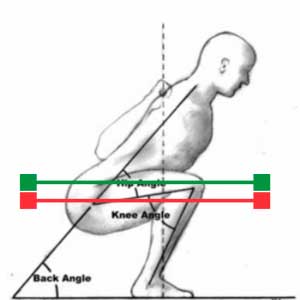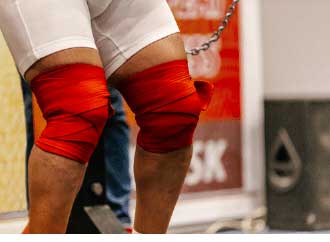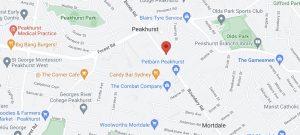Knee pain is common in patients. One of the frustrating questions we often have to answer is: Are squats bad for your knees? This question often comes after somebody has been talking to their doctor or their trainer, or the butcher, maybe the mechanic, maybe even the guy down the street. Now obviously these people feel like they are authorities on the topic. And the advice given to them is that knee squats are bad for your knees. This couldn’t be further from the truth.
Knee squats are not bad for your knees
On the contrary, knee squats aren’t bad for your knees, squats are fantastic for your knees, and we actually use them here to improve knee health. Now, before I go on to divulge just how we do that, I first want to make one point clear. You can’t go and do squats badly, and then come and tell us that squats are bad for your knees. You can’t butcher the movement, butcher the training and abuse the way that you do the squat, and then come and proclaim that squats are bad for your knees. That wouldn’t be truthful and it wouldn’t be right. Squats done properly are the most efficient way to rehabilitate injured knees, and further strengthen healthy knees.
Why squats are good for your knees
There are 3 important factors to consider when understanding why, contrary to mainstream advice, knee squats are beneficial for knee health:
- Squats need to be done correctly. They need to utilise the maximum amount of muscle mass, through the greatest effective range of motion.
- When done correctly, they maintain the strength balance between the major groups of muscles that create the most force on the knee joint.
- When done correctly, they are actually a hip drive movement, not a knee dominant movement. The loading on the knee joint itself is minimal.
Disclaimer: This is for Educational Purposes Only
Let me take a quick intercession to inform you as to the nature of our advice. We are experienced, healthcare clinicians. We wish to share our experience with you on topics to do with your health. We may be a little colourful in doing so, but at the heart of what we do is in-the-trenches experience. Whilst we have achieved academic success and understand the evidence, we are not solely evidence-based. We are, however, EVIDENCE INFORMED.
We find that the evidence is usually 10-15years (at minimum) behind what we are seeing in the clinic. We see real people, with real problems, and we’ve made a great living out of offering real solutions.
If all you’re after is the researched evidence, you can find some on Google Scholar, or you can very easily look for more on Google. We want to give you real-life advice, most of which you may not find in the research.
There is no way that this document can replicate or replace expert assessment and guidance given by a qualified registered healthcare practitioner who has seen you personally. I am sure you’re aware that I have no knowledge of your personal medical history or how you take care of your body. If you require care from a qualified practitioner, you would be best served by seeing someone who can empathise with your situation and treat you accordingly.
I’m sure you understand that I disclaim any and all responsibility for anything you do as a result of reading this document. And by reading this article, you accept 100% responsibility for the actions of you or anyone under your care.
Knee squats done correct
When we’re discussing knee squats done correctly, we’re talking about a few different criteria that have to be met. The first one is that you have to have a stance about hip-width apart with toes pointed out about 40°. This foot position may vary for different people, but that’s a good starting point. This forces the big glute muscles into action during the squat and allows the groin muscles to act as hip extensors. What this also does, is render every comment made by a physiotherapist that “your glutes aren’t activating” utterly stupid and meaningless.
The second one is that you have to take your bum back and lean forward, with a more horizontal back angle. This is counterintuitive to the normal teaching, where most trainers would teach you to keep your back more vertical. The reason for this is that it forces the hamstring muscles to act as anchors against your lower back and pelvis. Now the hamstrings are involved in a movement that was once thought of (stupidly) as a quadriceps exercise.
The third factor is that as you descend into the knee squat, we want your knees to shove outwards in the same direction as your toes are pointing. Doing this gets your knees out of the way, so your hips can actually sink below the top of the knees at the bottom position. This bottom position is referred to as the below parallel position. It will look like the bottom of your bum is sitting down below your knees, with your knees shoved out hard.

If you follow these basic criteria, you’ll be able to hit a great looking squat. The cue we use to guide this movement is “ass back, lean forward, knees out!” Done this way you will gain a full effective range of motion. A full effective range of motion is important because it utilises the maximum amount of muscle mass. And utilising more muscle means that when you begin to load the squats with weight, you can lift more weight. Lifting more weight, means you can get stronger. And that’s exactly what we want for your knees. We want them, and you, to get stronger.
Squats, even when they’re hacked, will load the front muscles of the thigh known as the quadriceps muscles. Done correctly, however, good knee squats will load the large group of muscles at the back of the thigh known as the Hamstrings. When we discuss knee health, the Quadriceps and the Hamstrings are important because they are the biggest force actors on the knee joint. A well-performed squat trains these muscles within the whole system, because the squat is a full-body movement that trains the whole body. As you descend into the squat, the Quadriceps pull the knee forward and the Hamstrings fight against that by pulling the knee backward, creating consistent tension through the movement.
Range of motion in squats
When you go down in a proper range of motion with your hips just below your knees at the bottom of the knee squat, there’s a constant tension between the Hamstrings and the Quadriceps. This allows for really good knee health as it strengthens those muscles and it also creates a really tense knee capsule that houses the knee joint. All those ligaments and tendons get stronger and ensure that you have really stable, strong knees.

Now when we describe to patients why squats are great for your knees, we’re also spending time telling them why squats are not bad for your knees. there’s often a misconception that if you hear lots of clicking and clacking through the knees, then squats can be bad for your knees. Done incorrectly they can be, but if you do them correctly with more of a horizontal back angle, with your knees shoved out, and allowing your hips to sink below your knees in the bottom position, you won’t load the knees improperly. You’ll actually load the hips.
Hips and squats
The squat is predominantly a hip centric movement. It promotes hip drive. Do it correctly in this way and you’ll avoid excessive load on the knees and you’ll actually strengthen your knees and your hips. If you do it in this fashion, all the muscles in the legs will get stronger, the glute muscles will get stronger, the back muscles will get stronger, it’s a total body movement. The whole body will get stronger.
Now one main thing I want to discuss with you when it comes to squatting, is that squatting is a natural human movement that humans have done ever since humans have been around. In the very earliest years of a child’s life, a toddler will spend most of their day sitting in a great looking squat playing with their toys. They get in and out of the squat seamlessly and effortlessly and they do it all day long. Another point I want to make is that every time you go to the bathroom to relieve yourself, you’re actually squatting down. Now before the advent of the modern toilet seat you used to squat down a lot further. When you look at these two factors, any logical thinking person would understand that squatting is one of the most adapted positions the body has.
We have spent our human existence building resilience to this position because it is obviously beneficial to our existence and our physical interaction with the world. As we get older, we have things that we need to worry about, like getting out of a seat, getting out of a car, getting off the toilet. If you want to do these things without pain and much effort, you need to learn how to squat properly. Be cautious about taking advice from anyone that tells you otherwise, as they generally haven’t thought about it enough to care.
Look, knee pain is one of the common issues that will decondition your body rapidly. You don’t want to get deconditioned. Keeping your knees healthy and strong is vital for a great quality of life. The most effective way to do this is to squat. Learn how to do it properly, plan it into your life and your knees will thank you for it.
If you feel that any of the information we’ve given you here resonates with you and you feel we are in a position to help, please BOOK ONLINE as we would welcome the opportunity. If you feel that we can help you in any other way, please reach out to us via our CONTACT PAGE.

Dr. Sami Karam, Osteopath
I’ve been a qualified Osteopath since 2004. I’ve been playing football ever since I could remember and I have a passion for it. I’ve played at the highest level in the NSW State League at both Youth and Senior levels, and have also been Head Physician at numerous State League Clubs. I’ve travelled internationally and consulted with Sports academies in Barcelona and Italy. I have a special interest in Strength and Conditioning for footballers, as I believe it gives them an edge in their physical competition. My passion involves bringing all of this knowledge into every single treatment that I provide for all athletes. If you feel that I can help you and want to reach out to me, contact me.



